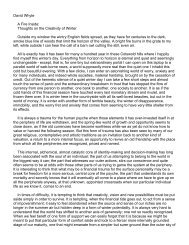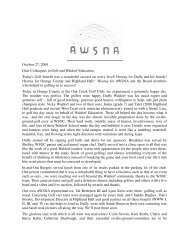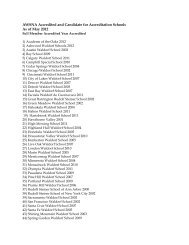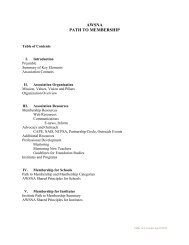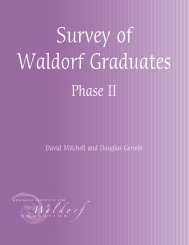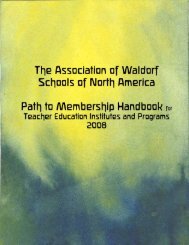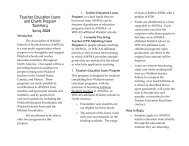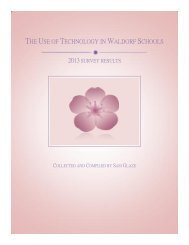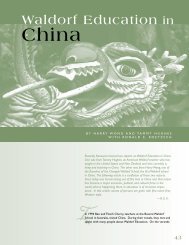Read More - Why Waldorf Works
Read More - Why Waldorf Works
Read More - Why Waldorf Works
You also want an ePaper? Increase the reach of your titles
YUMPU automatically turns print PDFs into web optimized ePapers that Google loves.
experimentation, our trials, and hopefully our successes.Across the US and abroad there are many inspiring school programs with predominantlyoutdoor curriculums, centered in practical and artistic activities, which work in consciousrelationship with nature and the seasons. Some of these programs work especially to meetthe needs of children with difficulties; and all of the programs mentioned below areguided by Rudolf Steiner’s indications for <strong>Waldorf</strong> and curative education. Theseinitiatives have shown great success in their work, and all have the potential to impact thefuture of education in the <strong>Waldorf</strong> movement and beyond. A few of these programs weredirectly inspired by Ege’s An Evident Need of Our Time, including a new initiative, theone program I will describe at length, which is scheduled to begin its first school year thisSeptember.THE EARTH: Education and Renewal Through the HandsA Program of the Hawthorne Valley AssociationProgram Begins September 2013Contact Stuart Summer at ssummer@hawthornevalleyschool.orgAround Hawthorne Valley, Ege’s original Evident Need vision of a Farm School, neverquite faded. His dream of fully integrating the practical and artistic with the academicendured, even as the exigencies of running a <strong>Waldorf</strong> School, with its treasure-ladencurriculum, filled the hearts and minds of the teachers. While aspects of the impulse livein the Association’s Visiting Students Program and <strong>Waldorf</strong> School (for more about theseprograms see Martin Ping’s article: Learning in Place on page xx) a new program hasemerged to more fully and intentionally embody Ege’s imagination of schoolexperience,life-experience, and nature-experience acting as one.In September 2013, The Hawthorne Valley Association is launching EARTH: Educationand Renewal Through the Hands, as a collaboration of the Hawthorne Valley <strong>Waldorf</strong>School and Farm Learning Center. EARTH will welcome a small group of middleschoolers struggling in the traditional classroom, to be part of its inaugural school year.The program is designed with a predominantly outdoor curriculum, and will engagestudents in practical, hands-on projects on and around the farm, supported by academicand artistic work related to their project themes. The children will begin each day withmorning chores: gathering eggs, feeding the animals, and other seasonally relevant tasks.After the bustle of an early morning outdoors, the students will join their <strong>Waldorf</strong> classand teacher for the scheduled main lesson block. Promptly thereafter, they will return tothe EARTH program for a hands-on project for the rest of the morning, andcorresponding academic and artistic work in the afternoons.Ege’s legacy streams through the EARTH’s thematically cohesive project curriculum,embracing nature and the rhythm and regularities of the seasons (something a traditionalschool schedule is unable to accommodate). In the fall, the students will work in thegarden, with harvesting and preservation as the central focus in the morning, and seedcraft, wreathes and plant dying as the parallel afternoon activities. Later in the fall, they
will harvest apples, explore the life and work of bees and insects, and deepen theirknowledge of the role of compost in the farm organism.In winter time, the Program’s blocks wll focus on cows, sheep, and then horses, as wellas forging, ice harvesting and maple sugaring. The afternoon blocks flow directly out ofthese practical concentrations and will include leatherwork, horn craft, felt, and fleece,and weaving and sewing their own bags and clothing. The children will study businessmath geared toward the project at hand – whether it be cow feeding, compost, or maplesyrup production. They will explore their experience of the economy of time andresources spent, and when they’ve harvested fall apples, grain or other foodstuffs, forgediron, or dipped candles, the children will meet the financial realities of selling their valueaddedproducts to the school community.In the spring, the students will shear and wash wool; learn to make cheese; meet the floraand fauna of gardens and streams; and experience plowing and planting, while painting,drawing, potting and sculpting.The EARTH program’s founder and lead teacher, Stu Summer, brings with him the fruitsof his experiences in land/place-based education and as a class teacher in a traditional<strong>Waldorf</strong> classroom for the past twenty years. Over the years, Mr. Summer hasencountered a number of students whose needs couldn’t fully be met by the <strong>Waldorf</strong>curriculum schedule. “There are kids that really struggle in the classroom, that prettymuch need to move around every seven minutes,” he explains, “but often those childrenwho struggle in the classroom become leaders in outdoor projects. These experiences cancreate confidence that supports breakthroughs in the classroom.” Summer’s colleagues atthe Learning Center are experienced <strong>Waldorf</strong> and farm-based educators, and have allobserved “problem children” become leaders and collaborators in the “field”.As early as Rudolf Steiner’s first experience of curative education as Otto Specht’s tutor,he observed that “the secret of the matter lay in the care and attention given to themovements of the limbs” 6 . His curative course emphasizes that “mere intellectualattention to the world can never work therapeutically; the feeling and the will must alsobe engaged” 7 and his seminal lectures on education and child development stress that“the right way is, as far as possible, to awaken the intellect through the will.” 8 As such,purposeful, project-based work in nature, where the will is actively engaged, can be keyto helping children with cognitive, volitional and social difficulties. The faculty and staffare designing the EARTH curriculum with these realities in mind. Their experiences haveconfirmed that by engaging in practical projects, children are more able to controlimpulsivity, increase their focus and concentration, and to work better in groups. Theprogram’s vision is that by activating both their will and intellect in such a rich andintegrated program, they will be happier, healthier, and will be able to apply themselves6 Steiner, Rudolf. Curative Education. Rudolf Steiner Press, London: 1972. p. 105. 7 Ibid. p. 110. 8 Steiner, Rudolf. Study of Man. Rudolf Steiner Press, Forest Row: 2004. p.156.
in any context. They will have a better sense of themselves, and have a stronger ability toconfront adversity and take initiative.OTHER RELEVANT PROGRAMSFARM-BASED EDUCATORS INSPIRED BY ANTHROPOSOPHY (FBEIBA)https://www.biodynamics.com/farm-based-educatorsFrom Their WebsiteFBEIBA's purpose is to cultivate collegiality, networking, and best practices in thisemerging field. We gather annually in the fall, in different regions of the country tofurther our mission.THE MOTHER EARTH SCHOOLPortland, Oregonwww.motherearthschool.comFrom Their WebsiteMother Earth School offers outdoor immersion preschool, kindergarten, and grades 1-3 attwo urban farms in Portland, OR. In these inspiring farm and forest settings, childrenblossom as they learn naturally from real life processes. As children develop a personalrelationship with the natural world, learning comes naturally as a sense of reverence forthe Earth and all life is cultivated.MULBERRY FARMSanta Rosa, Californiahttp://www.mulberryfarm.orgFrom Their WebsiteAt Mulberry, we have been working out of Curative Education for the last ten years, andwe have seen the results of Steiner's intentions carried out in the progress the childrenmake. Through this work many children have been able to return to a large classroomwithout significant difficulties and ready to take up their work academically and socially.Other children are served by Mulberry in that they can receive a <strong>Waldorf</strong> Educationtailored for their own time schedule; one that allows them to succeed at their own paceand feel real pride in their work. Farm chores have become an integral part of morningmovement time, and the children are very proud of their farm.RUSKIN MILLEnglandwww.rmt.orgAonghus Gordon is a remarkable educator. He is well known in <strong>Waldorf</strong> circles for hisremarkable work with the Ruskin Mill Education Trust in England since 1982, helping toturn lost youth around through a hands-on, nature- and place-based curriculum. Mr.Gordon was inspired to begin his work, back in the 1970s, by An Evident Need of OurTime by Karl Ege. Mr. Gordon is quoted as follows at a biodynamics conference last
year: “Meeting resistance in matter helps us move through our own inner resistance. Theblacksmith hammers out his own stiffness. The carpenter smooths her own rough edges” 9THE OTTO SPECHT SCHOOLChestnut Ridge, New Yorkwww.threefold.org/education/otto_specht_school/index.aspxFrom Their WebsiteThe Otto Specht School offers a developmentally appropriate academic and artisticcurriculum to small, individualized classes of children in grades 1 through 12. The schoolis designed for children with learning differences, alternative learning styles, and sensoryand social sensitivities. Classroom work is integrated with dramatic, visual, musical andmovement arts, as well as practical skills including cooking, weaving, woodwork,metalwork, farming and animal care.THE VISITING STUDENTS PROGRAM AT HAWTHORNE VALLEYGhent, NYwww.hawthornevalleyfarm.org/visiting-students-programFrom Their WebsiteThe Visiting Students Program at Hawthorne Valley, of which Ege’s Farm School visionwas the antecedent, brings school classes into a unique weeklong farm experience. Eachyear over 500 children come to visit the farm. Students, teachers, and farmers live andwork together. The rhythms of nature and farm life take children beyond the classroomand the everyday course of hectic, modern life. Awakening to the environment, thechildren rediscover the joy of learning and working that is so often missing in astructured, urban academic setting.FARM LEARNING CENTER AT HAWTHORNE VALLEYGhent, NYwww.hawthornevalleyfarm.org/farm-based-learningFrom Their WebsiteThe Hawthorne Valley Farm Learning Center seeks to inspire, strengthen and transformthe connection between people and the living land. Its goals are to provide opportunitiesto children and adults for farm-based, artistic experiences within the context of a workingbiodynamic farm, and to offer professional education in sustainable agriculture to thosewho choose farming as a vocation.9 http://biodynamicsbda.wordpress.com/2012/04/16/a-‐new-‐inspiration-‐for-education-‐a-‐report-‐from-‐the-‐western-‐waldorf-‐educators-‐conference-‐featuring-aonghus-‐gordon/



